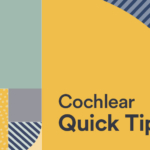The Minimum Speech Test Battery, Version 3 (MSTB-3) is an updated and streamlined test battery designed for adult cochlear implantation. Developed by the Institute of Cochlear Implant Training (ICIT), this essential tool serves two main purposes:
Pre-operative determination of candidacy: Clinicians use the MSTB-3 to assess whether a patient is a suitable candidate for cochlear implant (CI) surgery.
Post-operative assessment of cochlear implant performance: After implantation, the MSTB-3 helps evaluate how well the cochlear implant is functioning in adult recipients.
Here are the key points of this article and learning outcomes for clinicians:
- Understanding candidacy assessment for cochlear implant surgery using the new MSTB-3
- Understanding post-operative assessment and evaluation using the new MSTB-3
- Understanding the broader applicability of MSTB-3
A brief history of the MSTB…
The first version of the Minimum Speech Test Battery (MSTB) was introduced in 1996. It was later updated in 2011 to include the use of AzBio sentences1, as HINT sentences2 often resulted in ceiling effects when patients were tested in quiet. These early versions of the MSTB were readily adopted and widely used by clinicians for years.
Fast forward to 2022, when it was determined that the way we care for patients with cochlear implants had advanced significantly enough that an update to this test battery was needed. The revision was spearheaded by the ICIT, who recruited a group of experienced professionals to revise and update this classic test battery. The MSTB-3 team set out with several objectives in mind, resulting in the following updates:
- Electronic format for easier access to materials
- Comprehensive and streamlined testing for evaluating candidacy and post-operative performance
- Clear protocols so that clinicians receive defined guidelines
- Evidence-based recommendations
- Supplemental Information including patient questionnaires and cognitive screening tools
Detailed information about the MSTB-3 may also be found on the MSTB-3 website. This website not only provides clinicians with the ability to download test materials but also provides response forms, the MSTB-3 manual, patient questionnaires, test protocols, and so much more. For this article, we’d like to highlight some of the new and/or revised features of the MSTB-3.
The MSTB-3 Test Battery
The previous version of the MSTB provided a recommended test protocol as well as a reduced test battery that could be used if needed. This version of the MSTB3 does the opposite; it begins with a streamlined protocol, and suggests additional tests be administered only if supplemental information is needed to determine CI candidacy or to properly evaluate post-operative performance.
This streamlined battery recommends aided speech recognition testing be preceded by unaided audiometric testing and verification of hearing aids to ensure that candidacy decisions are based on the patient’s “best aided” condition, which the MSTB-3 defines as “testing using a hearing aid that has been optimized for hearing loss in the ear to be implanted.” Speech recognition testing begins with administration of CNC Monosyllabic Words with each ear in the “best aided” condition to determine if one, both, or neither ear meets the clinic’s predetermined CNC score for a cochlear implant. Subsequent testing involves administration of AzBio sentences in the “best aided” condition where testing focuses on the ear to be treated. Importantly, sentence scores provide additional information for candidacy decisions, and are often used to determine if the patient qualifies for insurance coverage since many insurers specify a sentence score that must be met to qualify for a CI. Finally, the MSTB3 recommends clinicians consider evaluating the patient’s speech recognition skills in their “Everyday Listening Condition,” which involves testing with the optimized hearing configuration the patient uses in their everyday listening. This typically varies from patient to patient and may include bilateral hearing aids, unilateral hearing aid, or a bilateral unaided/unoccluded situation, depending on the configuration of their hearing loss.
Patient reported outcome measures (PROMs) are then administered to collect additional information regarding areas of listening that provide particular challenges for the patient. If the clinician determines the patient is an appropriate candidate for a CI, they are referred on for medical evaluation. The PROMs recommended by the MSTB-3 include the CI-QOL 10 Global3 and the SSQ-124. Links to both questionnaires are provided on the MSTB-3 website.
Here is a breakdown of the key points from the MSTB-3 recommendations:
- Speech Recognition Testing:
- Unaided audiometric testing to establish the patient’s baseline hearing.
- Aided speech recognition using a hearing aid optimized for the ear to be implanted (referred to as the “best aided” condition).
- CNC Monosyllabic Words: Administered in the “best aided” condition for each ear.
- AzBio Sentences: Also administered in the “best aided” condition, focusing on the ear to be treated.
- Everyday Listening Condition:
- This involves testing with the optimized hearing configuration the patient uses regularly.
- The specific configuration varies (e.g., bilateral hearing aids, unilateral hearing aid, or unaided) based on the patient’s hearing loss.
- Patient-Reported Outcome Measures (PROMs):
- The recommended PROMs include CI-QOL 10 Global and SSQ-12.
Protocol for patients with Single-Sided Deafness (SSD)
In addition to the test protocol described above, the MSTB-3 provides a recommended candidacy protocol for use with patients with SSD. This test battery is similar to the battery used with traditional candidates, but additionally includes more difficult signal-to-noise ratios. Although indications for SSD often base decisions on CNC scores, the MSTB-3 recommends sentence testing with spatially separated noise to replicate the difficulties experienced by such listeners. Data obtained from such testing often provides additional support for candidacy decisions and may be used to support requests for coverage by the patient’s insurer.
Cognitive Screening
Unlike previous versions, the MSTB-3 manual provides a literature review regarding cognitive evaluation considerations. Although the MSTB-3 does not specifically recommend the completion of a cognitive screener for all adult patients, decisions about such a screener should be left to the discretion of the clinician. The MSTB-3 does recommend that clinicians should be adequately trained before administering any type of cognitive screener, and that tools should be selected based on validity, specificity and sensitivity to mild cognitive impairment. Importantly, the MSTB-3 states that results of a cognitive screener should not be used to exclude a patient from cochlear implant candidacy.
Report Templates
Lastly, to further support continuity of care across clinicians, the MSTB-3 provides sample report templates for pre-operative determination of candidacy, post-operative programming, and an “After Visit Summary” that can be given to patients to ensure they are informed of the results of the appointment(s).
Summary
In summary, the MSTB-3 provides a wealth of information that can be used by clinicians to guide their decision-making as they evaluate a patient’s candidacy for a cochlear implant and as they evaluate post-operative performance with a CI. The team that led development of the MSTB-3 is hopeful the protocols and test materials will increase consistency among clinicians regarding test procedures being used. Importantly, the MSTB-3 provides an important opportunity for other areas of audiology to utilize the MSTB-3 resources to improve the care they provide. The patient reported outcome measures are highly appropriate for all patients with hearing loss, and do not only apply to patients with CIs. The discussion about cognitive screening is also applicable to all patients with hearing loss. Importantly, the MSTB-3 provides downloads of the CNC Monosyllabic Words Test, which could be used by clinicians to evaluate speech recognition over time with hearing aids. Wouldn’t it be great for patients if a CNC score followed them throughout their hearing journey, and we were able to track, over time, how a patient understands words when using appropriate hearing technology? Knowledge of a patient’s aided word recognition would not only serve to enhance counseling but could also be used to identify patients who may be in need of different technology. For example, a CNC score could help determine when the time is right to transition from an over-the-counter hearing aid to a more prescriptive fitting, or when it’s time to transition from a prescription hearing aid to a cochlear implant. It’s exciting to think that this battery could help more patients than just those who use cochlear implants.
- Spahr AJ, Dorman MF. Performance of subjects fit with the Advanced Bionics CII and Nucleus 3G cochlear implant devices. Arch Otolaryngol Head Neck Surg. May 2004;130(5):624-8. doi:10.1001/archotol.130.5.624130/5/624
- Nilsson M, Soli SD, Sullivan JA. Development of the Hearing in Noise Test for the measurement of speech reception thresholds in quiet and in noise. J Acoust Soc. Am. 1994 Feb;95(2):1085–1099.
- McRackan TR, Hand BN, Velozo CA, Dubno JR. Validity and reliability of the Cochlear Implant Quality of Life (CIQOL)-35 Profile and CIQOL-10 Global instruments in comparison to legacy instruments. Ear and Hearing. Jul-Aug 2021;42(4):896-908. doi:10.1097/Aud.0000000000001022
- Noble W, Jensen NS, Naylor G, Bhullar N, Akeroyd MA. A short form of the Speech, Spatial and Qualities of Hearing scale suitable for clinical use: the SSQ12. Int J Audiol. Jun 2013;52(6):409-12. doi:10.3109/14992027.2013.781278
Acknowledgements
The MSTB-3 team included Camille Dunn and Terry Zwolan (co-leads), Thomas Balkany and Heather Strader (ICIT), and the following content experts: Allison Biever, Rene’ Gifford, Melissa Hall, Heidi Hill, Meredith Holcomb, English King, Jan Larky, Regina Presley, Meaghan Reed, William Shapiro, Sarah Sydlowski, and Jace Wolfe. Financial support for development of the MSTB-3 was provided by Advanced Bionics, Cochlear Americas, and MED-EL.


